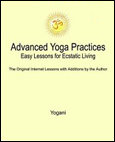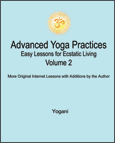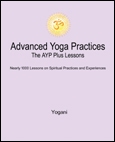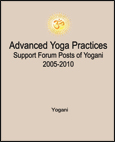|
Public Home | Plus Home | Main Lessons | Tantra Lessons | Public Forum | Plus Forum | Downloads | Books Topic Paths | Search | Training-Retreats | Testimonials | Survey | Interviews | MultiMedia | Contact | Donate |
|
Advanced Yoga Practices Note: For the complete lessons, with additions, see the AYP Easy Lessons for Ecstatic Living Books. For the Expanded and Interactive Internet Lessons, AYP Online Books, Audiobooks and more, see AYP Plus. Lesson 316 - More Shatkarmas and Overall Guidelines (Audio)
AYP
Plus Additions:
From: Yogani New Visitors: It is recommended you read from the beginning of the web archive, as previous lessons are prerequisite to this one. The first lesson is, "Why This Discussion?"
The first three of these shatkarmas are cleansing techniques in the physical sense, and have been covered in the previous three lessons. The remaining three shatkarmas are also physical, but do not involve flushing out the cavities of the body with water. They are more intimately involved in our daily yoga practices, and have, in fact, been covered to one degree or another in previous AYP lessons. If they have not been covered in name, then certainly in principle as applied in other practices in the overall routine of practices, including asanas, spinal breathing pranayama and deep meditation. We will review the last three shatkarmas and their interconnections with previously covered practices here: Nauli Nauli means to churn. It is a dynamic version of uddiyana bandha(abdominal lock), and consists of twirling the abdominal muscles, first in one direction, and then the other. Nauli stimulates the higher functioning of the digestive system by raising ecstatic kundalini energy up from the pelvic region into active participation with food and air in the GI tract, leading to whole body ecstatic conductivity. In the process, it provides stimulation for deep cleansing in the bowels. It can be practiced as part of asanas (yoga postures), and also during basti (enema) and dhauti (intestinal wash) to enhance cleansing and elimination when the bowels are full with saline water. Before undertaking nauli, it is necessary to become proficient in uddiyana bandha, which is part of the routine of asanas (postures) undertaken before spinal breathing pranayama and deep meditation. For details on the asana routine, see Lesson 71. In practicing uddiyana, we stand with feet shoulder-width apart with hands resting on knees. Then we expel the air fully from our lungs and pull the abdomen inward by lifting the diaphragm upward into the lung cavity. This is held for several five-second durations, or longer, as comfortable. Uddiyana means to fly up, which becomes apparent to many as soon as the practice is used. The inner energy literally flies up. Nauli is a dynamic, or expanded, version of uddiyana, meaning it involves rhythmic movement, of the abdominal muscles, rather than holding a static position. The churning in nauli is accomplished by alternately flexing the left and right abdominal muscles to achieve a twirling effect. This is done in the same position as standing uddiyana, with air expelled and diaphragm lifted, while flexing the abdominal muscles (like when doing a sit-up), first against one knee through the supporting arm, and then against the other knee through the other supporting arm. This leads to the ability to control the flexing of left and right abdominal muscles separately, the key to accomplishing the twirling effect. Then nauli can be practiced any time in any position. It also becomes a less externally visible internal practice. It is a great aid to digestion and elimination. Nauli is typically practiced during asanas at the same spot in the routine as uddiyana bandha, adding 10-20 twirls in each direction. Over time, nauli becomes a subtle automatic reflex in the body that contributes to vast inner flows of ecstatic energy. By then, cleansing has become very refined. Further detailed instructions on uddiyana bandha and nauli can be found in Lesson 129. Nauli is a powerful yoga practice and is best undertaken after the routine of asanas and sitting practices is well established. And then it should be measured and self-paced with prudence for steady, safe progress in its effects. A short duration of nauli practice will go a long way. Kapalbhati Kapalbhati means shining forehead. It is also interpreted to mean luminous face. It is a pranayama (breathing) technique, which involves taking a series of relaxed normal inhalations followed by sudden bellows-like exhalations. Inhalation is normally done through the nose, but can be done through the mouth if there is nasal obstruction. Exhalation is normally done through the nose also, but can also be done through the mouth with pursed lips to slightly restrict the exit of air. A primary effect of kapalbhati is to increase air pressure in short bursts in the nasal pharynx and sinuses, which stimulates the forward part of the brain. This provides a brain cleansing. Kapalbhati can be repeated for a series of 10-20 cycles of relaxed inhalation and sudden exhalation. Be careful not to overdo this practice. A good time to practice kapalbhati is after yoga asanas and right before twice-daily sitting practices, which includes spinal breathing pranayama and deep meditation. The effect of kapalbhati is purification of the neurobiology in the upper body, and in the head in particular. Hence the phrases, shining forehead and luminous face. It can give the internal sensation of energy radiating, and sometimes the external appearance of radiance in the face. The principles and effects of kapalbhati are also found in spinal bastrika pranayama, which is a more advanced and broad-based practice utilized in daily sitting practices in the AYP system. Spinal bastrika also provides additional benefits for purification of the entire spinal nerve (sushumna) extending between the root (anus/perineum) and the center brow, and the entire nervous system radiating out from that central channel in us. Spinal bastrika pranayama may be selected over basic kapalbhati in daily sitting practices as our yoga routine advances over time. Detailed instructions for spinal bastrika pranayama can be found in Lesson 171. Trataka Trataka means steady gazing. It involves fixing the gaze on an object and leaving it there for a period of time. It purifies the inner machinery of attention, which in most of us comes out through the eyes for most of our waking hours. Fixing the gaze helps to loosen the grip of external experiences on the attention. In many traditions, trataka, or some form of it, is used as a preparation for sitting practices. In some systems of practice, it is used as a primary meditation technique the legendary practices of candle gazing, or staring at a wall. In the AYP system of practices, we do not stare at a candle or a wall, at least not as a primary practice. Instead, we gently train the attention in inward ways to attend to the two primary processes of spiritual transformation that occur naturally in the human nervous system. -- The cultivation of inner silence, which is consciousness itself, before it has been focused as attention on any object. This is accomplished through deep meditation, and additional methods. -- The cultivation of ecstatic conductivity, which is the dynamic energetic aspect of our nature. This is accomplished with spinal breathing pranayama, and additional methods. Both spinal breathing pranayama and deep meditation involve the use of attention more sophisticated forms of steady gazing, we could say. In each case the primary technique is easy favoring a procedure utilizing attention with eyes closed, similar to how we would favor the object of our gazing with eyes open in trataka. Each time we wander off, we just easily bring the attention back. We are doing this with the simple procedures of spinal breathing pranayama and deep meditation. For the predetermined times of practice, they become our object of gazing, so to speak. It might seem like a stretch to say that spinal breathing pranayama and deep meditation are forms of trataka. In fact, they are expansions on the principle, much in the way that spinal bastrika pranayama is an expansion on the principle of kapalbhati. It is taking basic principles and incorporating them into broader methods of practices, which are simple, yet far more global in their effects. In AYP we use a simple form of trataka to aid in the development of sambhavi mudra during our spinal breathing pranayama, where the physical position of the eyes is separated from the movement of attention up and down the spinal nerve during inhalation and exhalation (see Lesson 131). In sambhavi, the eyes are raised and centered slightly, with an imperceptible furrowing of the center brow. This raising and centering of the eyes while they are closed is done during spinal breathing, while the attention is favoring cycling up and down the spinal nerve (center of the spinal column) between root and brow during inhalation and exhalation. It takes some practice to learn to maintain sambhavi during spinal breathing, and a simple trataka exercise can help with this. It is done by keeping the eyes open and keeping a steady gaze on an external object while tracing the spinal nerve with the attention while breathing easily. This is neither spinal breathing pranayama, nor sambhavi mudra, but a preparation for doing sambhavi during spinal breathing. A little trataka like that will go a long way toward stabilizing our inner sambhavi practice (eyes closed) while we are doing spinal breathing pranayama, and a range of other yoga practices. So, trataka can be a preparation for other practices by revealing to us the relationship of attention and the positioning of our eyes, and helping us develop better versatility with our attention in relation to the full range of practices we are doing. The principle of trataka (the favoring of an object or yoga procedure with attention) can be found in many practices. As we have seen, the last three shatkarmas, or their underlying principles, are largely incorporated in the AYP system of practices already. Some additional benefits may be gained by practicing them separately in the traditional way. However, this may not be the ideal utilization of shatkarmas. The inner principles they stimulate through external manipulations are akin to the mudras and bandhas, and these kinds of practices are most effective when integrated with the core practices of spinal breathing pranayama and deep meditation. By integrated, we do not mean practiced at the same time. We mean combined in the daily routine in a way that optimizes the effects of our overall practice routine, which will facilitate steady progress in spiritual unfoldment with comfort and safety. Without comfort and safety, progress cannot be sustained, and sooner or later we will be compelled to curtail practices for a time. So, a wise course of action with practices is to engage in self-pacing, which means regulating practices in a way so as to balance progress with comfort and safety. At times this may mean not doing certain practices at all. Shatkarmas are especially helpful if one is well-established in a steady routine of sitting practices, because there is a substantial spiritual dimension to them. Shatkarmas are an important aid for cultivating ecstatic conductivity in the neurobiology. The GI tract plays a central role in this, but not necessarily in the beginning days of our practices. It is much more important to become stable in our core practices. From the AYP point of view, shatkarmas are middle stage practices, not needed much by most practitioners to enhance spiritual progress at the beginning or at the end of the journey. They are very helpful in the middle when ecstatic conductivity is coming into play. Of course, for health reasons, shatkarmas can be useful anytime, so they straddle the spiritual and physical health arenas, as do all yoga practices. Here we are focusing primarily on the spiritual side. If we are involved in the AYP integrated application of deep meditation, spinal breathing pranayama, asanas, mudras and bandhas, we will have the principles of nauli, kapalbhati and trataka already incorporated into our daily routine. What will be new at this stage in the lessons is the inner washing shatkarmas jala neti, basti and dhauti. In the case of these three, it is suggested to see how the rise of ecstatic conductivity stimulates our desire to do them, rather than forcing them prematurely into our daily routine. If we take this approach, a time for the inner washing shatkarmas will become clear. As the inner neurobiology begins to stir in the nasal passages, sinuses and GI tract, we will know when it is time to be providing extra cleansing in these areas. Ecstatic conductivity is cultivated mainly by spinal breathing pranayama, mudras, bandhas and additional forms of pranayama. Prerequisite to this is the rise of inner silence, which is cultivated mainly in deep meditation and samyama. So you can see there is a lot that will be happening before certain shatkarmas will be capable of producing their maximum effects. This is the most practical way to approach the inner washing shatkarmas when we feel called to them from within, then we do them. If not, then we will not be shortchanging ourselves spiritually by not doing them. Deep meditation, spinal breathing pranayama and other sitting practices are more important factors in our spiritual transformation. The interconnectedness of yoga will naturally call us to shatkarmas and the other yamas (restraints) and niyamas (observances) as our inner unfoldment requires. All yogic methods are part of the overall process of human spiritual transformation that resides within each of us. The guru is in you.
Discuss this Lesson in the AYP Plus Support Forum Note: For detailed instructions on shatkarmas (cleansing techniques), see the Diet, Shatkarmas and Amaroli book, and AYP Plus. |
|
|
|
Join the Mail List:
AYP Retreats
eBooks - PDF, EPUB
FREE eBooks with
SAVE with Bundled
|

























